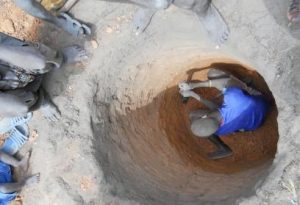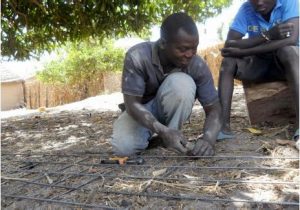This project has been completed under the direction of Peace Corps Volunteer Joey Johnston.
To read about the beginning of the project, CLICK HERE.
The project was to construct 12 simple cement-lined and capped pit latrines.
Joey reports:
The people of Ngouye Marie are thankful that there is now a functional latrine in each family compound. We made use of local resources and unofficial social networks to make every dollar count. In total, 12 latrines were constructed.
Villagers understand the importance of latrines for sanitation and preventing the spread of diarrheal disease. Villagers are also pleased that guests in the village will now be better accommodated.
Most of the work for the project was done directly by the villagers at no charge. Families dug between three and four meters into the ground, creating a simple pit.
Rocks and sand (which are sold as construction materials in Senegal) were collected from communal lands and old construction sites and carted to the site of the latrine. Once the family had made this labor commitment, I purchased two 50 kg sacks of cement, six long iron bars, and contracted a local mason to use these materials to build the concrete latrine cover. The mason, himself a villager, agreed to build each latrine cover for half the price he usually charges. Finally we mounted the latrine covers over the pit.
The three meter pit will fill up in a few years. But the mason estimates that the concrete cover should last up to twelve years. Villagers know that when the latrine fills, they can move the cover to a new pit.
The sanitation system in Ngouye Marie has been dramatically improved. It’s clear, however, that work still needs to be done. Culture-based sentiments of embarrassment prevent everyone from using the latrines. There is a resistance among some of the villagers to share a latrine with their extended family relations. Hopefully, the villagers’ new appreciation for latrines will inspire them to construct more latrines on their own in the future.
We are grateful to Joey for promptly completing this project, and again wish to thank the Elmo Foundation for providing the funding.

